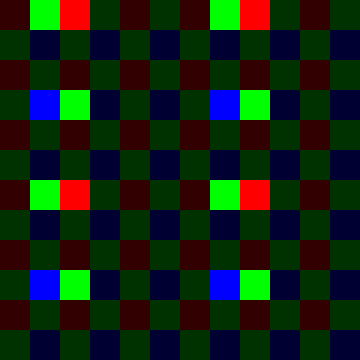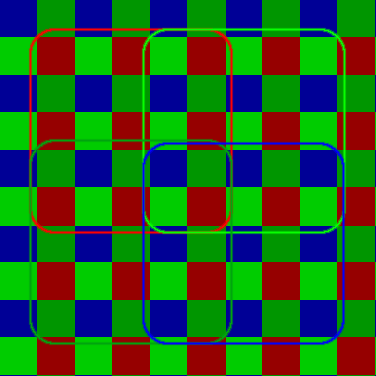This is a more detailed description of Pixel Binning, including specific examples from Canon cameras.
When the cameras software does not process every single photosite, what happens is that every single Bayer photosite processed by the camera might be obtained by averaging data from a few photosites. This averaging process happens in the analog domain. When pixel binning is used, the image received/processed by the camera software is already pixel-binned (the image sensor is not read out at its full resolution).
Advantages:
- relatively simple to implement with analog electronics;
- all sensor photosites contribute to the final image (nothing is lost), unless Line Skipping is used;
- lower data rate to process for a single LiveView or video frame;
- easier to achieve a high frame rate without requiring huge processing power (compared to a complete readout at full resolution, followed by a resizing step in digital domain);
- reasonably good performance on high-frequency details (very few aliasing/moire issues on a Resolution Chart).
Disadvantages:
- less image detail (compared to a full resolution image resized to match video resolution);
- some noise introduced by analog electronics (compared to averaging the same pixels in software, from a full resolution image);
- available binning factors are hardwired.
Most Canon cameras use Line Skipping (a variation of pixel binning, which only combines the photosites from one single line, and discards the data from the other lines in a 3×3 or 5×3 block, see below). It's easier to implement in hardware, but the main disadvantage of line skipping is poor performance with high-frequency details (severe aliasing/moire issues).
Canon cameras generally use the following pixel binning modes:
Pure pixel binning modes (without line skipping) - 5D Mark III:
- 3×3 binning: for every pixel, 9 photosites (3 lines x 3 columns) of the same Bayer color are averaged together. Used on 5D Mark III in 1080p video modes. See figure →
- 5×3 binning: for every pixel, 15 photosites (5 lines x 3 columns) of the same Bayer color are averaged together. Used on 5D Mark III in 720p video modes.
- 1:1 crop (no binning, sometimes called “crop mode”). Used on all cameras when capturing a full resolution image. Also used on Canon cameras in x5/x10 zoom modes in LiveView.
Pixel binning modes with line skipping - most Canon EOS cameras:
- 3×3 column binning / line skipping. For each 3×3 block of photosites, only one of the 3 lines is averaged (all 3 columns from this line, of the same Bayer color, being averaged together), in order to create a pixel in the LiveView image. The remaining 2 lines are discarded (skipped); that is, the video image is created from 33% of the photosites on the image sensor. Most Canon EOS cameras use this method to implement 1080p video (5D Mark III is an exception). See figure →
- 5×3 column binning / line skipping. Used by most Canon EOS cameras to implement 720p video. For every line read out from the sensor, 4 lines are discarded (skipped).
Pixel binning patterns will affect camera's native resolution in video mode.
Custom binning modes enabled by Magic Lantern (currently available in some experimental versions of the crop_rec module):
- 1×3 binning: a custom binning technique which operates on blocks of 1 line and 3 columns. It acts as a middle ground between 3×3 (1080p) and 1:1 (full resolution). This mode uses all photosites from the image sensor, by reading every single line, and does not have any noticeable aliasing/moire issues. Also known as Anamorphic.
- 3×1 binning / line skipping: another custom binning technique, using blocks of 3 lines and 1 column, requiring the same data rate as with 1×3 binning. Not very useful in practice, because of the aliasing/moire issues.
- 3×3 line/column skipping: from each 3×3 group of photosites, only one photosite is read out; all others are discarded. The layout is a little unusual. Extreme aliasing/moiré issues. See figure >


→ ML Forum: Pixel binning patterns in LiveView
→ Simulation: 1x3 "column binning" vs 3x1 "line skipping" vs 3x3 binning/skipping
→ Line Skipping
→ Native Resolution
→ crop_rec
→ Anamorphic

